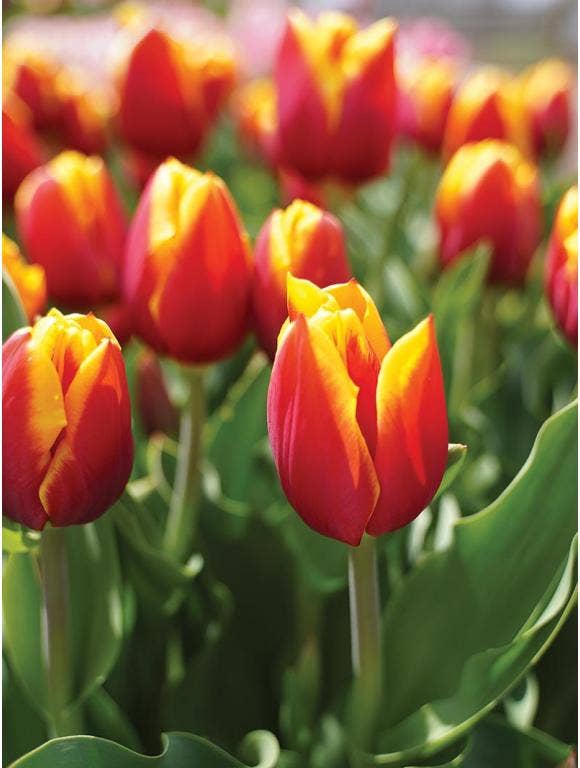


Few sights cure winter blues like the spectacular colors from tulip bulbs and other spring bloomers. Whether you're debating your first bulbs to plant in the fall or expanding an existing spring flower bed, here are some gardening tips to make those spring flowers sing and to celebrate the start of the growing season.
What Are Flower Bulbs?
Many of the earliest (and arguably the showiest) spring flowers come from bulbs you plant in the fall. Bulbs help store the energy these perennial plants need to bloom each year. The earliest bloomers, such as daffodils, may sprout green shoots even before the last snow has melted. Daffodils, tulips, hyacinths, anemones, alliums and Asiatic lilies rank among the popular bulbs to plant in the fall.
Bulbs can also be a loose term for perennial plants with other types of underground growths that store nutrients and energy. White and purple crocuses have small corms and are usually the first flowers to bloom as winter wanes. Irises, which have knobby rhizomes, and peonies, which have tuberous roots with eyes, should also be planted in the fall for late-spring swaths of color as later-blooming tulips fade.
Look for bulbs in September and October, or preorder online for fall shipping. Inspect your bulbs before purchasing or once they arrive by mail. They should be clean and firm, and free of mold or soft spots that could indicate rot or bruising.
When Should I Plant Bulbs?
Choose a dry, cool fall day for planting tulip bulbs and other spring bloomers, usually in mid-September to mid-October. Bulbs should stay dormant, but they'll be able to put down some roots before the ground freezes for the winter.
How Should I Plant Bulbs?
You can use a bulb planter to make holes and put bulbs in the soil one by one or dig a fresh bed if you have dozens of bulbs to plant in the fall. Use a trowel or hoe to work the soil, making sure it's crumbly and loose. Add compost to hold moisture, but also keep the garden bed well-drained so pooling water doesn't rot the bulbs. You may work some fertilizer into the soil, as well, if needed.
How Deep Should I Plant Bulbs?
A general rule for planting tulip bulbs is to bury them by two to three times their width. A 2-inch bulb, for example, should be covered with 4 to 6 inches of soil. Tiny crocus corms only need to be covered with an inch of soil.
Read your bulb packaging to get the exact instructions for the flowers you're planting. An iris rhizome, for example, is planted shallowly. Peonies need to have their crowns — the upper part of the tuber where the buds emerge — at soil level.
Water the freshly planted bulbs to help settle the soil and encourage them to set roots before a winter freeze triggers dormancy.
How Do I Care for the Bulbs Over the Winter?
Mulch your bulb garden or cover it with fall leaves to help insulate for winter. Mulch can protect bulbs from damaging deep freezes while also keeping them cool, so rogue late-winter warmups don't coax them to emerge too early only to be hit by another freeze.
How Do I Protect Bulbs From Deer?
If your yard is prone to visits from hungry deer, you can lay down and secure a light chicken wire screen over the top of your soil or try a deer repellent product.
While tulip bulbs are particularly tasty to deer, planting them with or surrounded by daffodils (not a deer favorite) can also help.
How Can I Best Show Off Bulbs?
Plant flowers in odd-numbered clusters rather than rows for the showiest gardens. Look for pre-mixed groups of bulbs, or group together complementary colored or contrasting bulbs that will bloom simultaneously. For example, group yellow daffodils, purple crocuses and pastel hyacinths for early bloomers or magenta alliums with brightly striped tulips for a later bloom.
You can also look for or create your own blends of daffodils in creamy whites, bright yellows and orange cups. Or use tulip mixes featuring patterns and textures, such as fringed or peony tulips planted in front of tall classics such as Darwin hybrid tulips in bold solids or bicolor blends.
Whatever you start with, the hundreds of varieties ensure a never-ending palette of lush, lovely spring flowers you can add in the years to come.
Check out Burpee's wide variety of tulips, daffodils, crocuses and hyacinths for your fall bulb planting.



